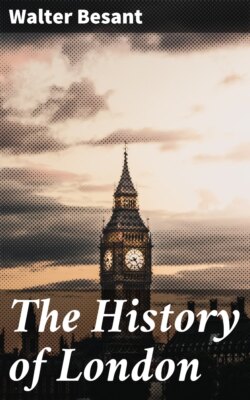Читать книгу The History of London - Walter Besant - Страница 4
На сайте Литреса книга снята с продажи.
ОглавлениеEARLY BRITISH POTTERY.
Let us consider this question as regards London. Look at the map called 'Roman London' (p. 15). You will there see flowing into the river Thames two little streams, one called Walbrook, and the other called the Fleet River. You will see a steep slope, or cliff, indicated along the river side. Anciently, before any buildings stood along the bank, this cliff, about 30 feet high, rose over an immense marsh which covered all the ground on the south, the east, and the west. The cliff receded from the river on the east and on the west at this point: on either side of the Walbrook it rose out of the marsh at the very edge of the river at high tide. There was thus a double hill, one on the east with the Walbrook on one side of it, the Thames on a second side, and a marsh on a third side, and the Fleet River on the west. It was thus bounded on east, south, and west, by streams. On the north was a wild moor (hence the name Moorfields) and beyond the moor stretched away northwards a vast forest, afterwards called the Middlesex forest. This forest covered, indeed, the greater part of the island, save where marshes and stagnant lakes lay extended, the haunt of countless wild birds. You may see portions and fragments of this forest even now; some of it lies in Ken Wood, Hampstead; some in the last bit left of Hainault Forest; some at Epping.
The river Thames ran through this marsh. It was then much broader than at present, because there were no banks or quays to keep it within limits: at high tide it overflowed the whole of the marsh and lay in an immense lake, bounded on the north by this low cliff of clay, and on the south by the rising ground of what we now call the Surrey Hills, which begin between Kennington and Clapham, as is shown by the name of Clapham Rise. In this marsh were a few low islets, always above water save at very high tides. The memory of these islands is preserved in the names ending with ea or ey, as Chelsea, Battersea, Bermondsey. And Westminster Abbey was built upon the Isle of Thorns or Thorney. The marsh, south of the river, remained a marsh, undrained and neglected for many centuries. Almost within the memory of living men Southwark contained stagnant ponds, while Bermondsey is still flooded when the tide is higher than is customary.
